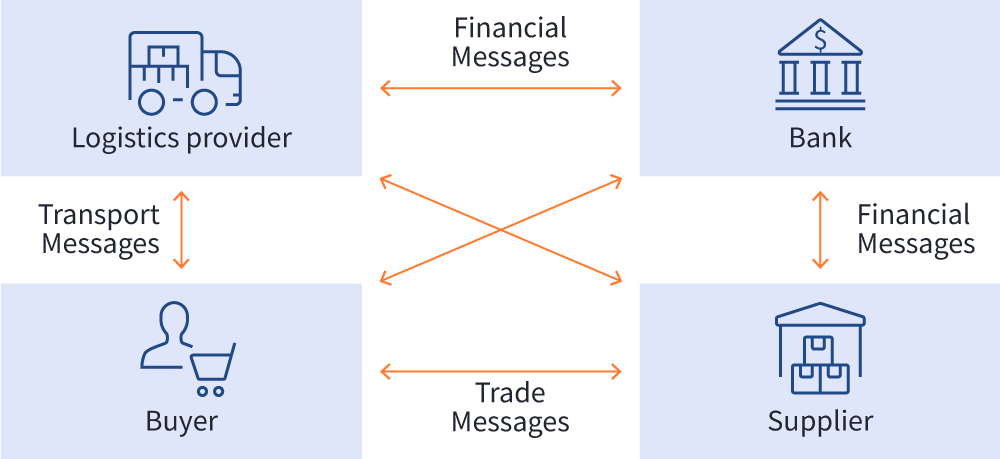EANCOM EDI Document Standard
EANCOM provides a logical sequence of messages used in business. Trading companies agree together on messages adapted to their needs. Standard messages available in EANCOM can be divided into the following categories, Master Data, Commercial Transactions, Report & Planning and Transporter.
The messages available in the EANCOM® standard cover the functions required to effect a complete trade transaction:
- the messages which enable the trade transaction to take place, e.g. price catalogue, purchase order, invoice, etc.;
- the messages used to instruct transport services to move the goods;
- the messages used in settlement of the trade transactions through the banking system.
The flows and business partners catered for in EANCOM can be simply represented as follows:
The business messages available in EANCOM can be divided into the following categories:
Master Data Messages
These contain data which rarely changes (product measurements, names and addresses,…) :
- The Party Information message : is used to identify all the locations (EAN location numbers : name, address, contact persons, financial accounts,…) associated to subsequent commercial transactions and their related operational information.
- The Product Information messages : provide parties with information containing the descriptive, logistical and financial details of a product or a service.
Commercial Transactions Messages
These cover the general trading cycle from quotation request to remittance advice:
- The Quotation messages contain all details relevant to the supply of the goods or services requested by the potential buyer (terms of delivery, payment terms, price, allowances and charges,…).
- The Purchase Order set of messages relates to the ordering process from a proposed order, subsequent changes and the eventual order confirmation (relevant quantities, dates, location of delivery,…).
- The Transport and Logistics messages provide information related to the dispatch transport and receipt of previously ordered products.
- The Invoice and Remittance Advice messages relate to the payment of the goods supplied. The buyer can automatically reconcile the suppliers invoice using the product receipt information.
Report and Planning Messages
These messages include general trading reports which allow partners to plan for the future. They enable business partners to exchange precious information in order to understand each others’ requirements. They provide valuable and up-to-date reports and forecasts concerning delivery, sales and stocks and enable the partners involved to plan their activities and marketing strategies.
- Syntax and Service Report message may be sent by the receiver of any EDIFACT message to acknowledge or refuse an interchange, functional group or message.
- General Message may be used to send data for which there is no specific standard message.
What are the benefits of EANCOM?
In EDI, it is essential to unambiguously identify the products or services as well as the parties associated with the transaction. Coding the information exchanged in EDI is essential for automatic processing.
In EANCOM messages, each product defined in its widest sense is identified by a unique EAN standard article number and each party is identified by a unique EAN location number. Use of the EAN standards in EDI provides the following significant benefits:
- Uses a Standard Numbering Convention – EAN identification numbers are unique and recognized world-wide. Use of EAN standard numbers means business partners do not have to maintain complex cross-references for each business partner’s internal codes.
- Standard Messages are simple and accurate – The unambiguous coding of products and locations greatly simplifies EDI messages, reducing transmission costs and facilitating processing.
- Multi-Industry Standard – The non-significant characteristic of the EAN numbers allows any item to be identified and consequently any business, regardless of its activity, can use EANCOM.
- International – EANCOM messages are used world-wide. The international network of EAN Numbering Organizations, covering more than 80 countries, provides EANCOM support in their local language to an increasing number of user companies world-wide.
- Maintenance and Support – EAN and its Numbering Organizations are strategically committed to maintain and further develop EANCOM. Representatives from various industries have established several project teams with the objective of analyzing specific issues and developing business oriented solutions.

